
A vulture is a bird of prey that scavenges on carrion. There are 23 extant species of vulture. Old World vultures include 16 living species native to Europe, Africa, and Asia; New World vultures are restricted to North and South America and consist of seven identified species, all belonging to the Cathartidae family. A particular characteristic of many vultures is a bald, unfeathered head. This bare skin is thought to keep the head clean when feeding, and also plays an important role in thermoregulation.

The Bournda National Park is a 2,655-hectare (6,560-acre) protected area in New South Wales, Australia, managed as a national park by NSW National Parks and Wildlife Service, and was established on 24 April 1992. It forms part of the Ulladulla to Merimbula Important Bird Area, identified as such by BirdLife International because of its importance for swift parrots.

Frigatebirds are a family of seabirds called Fregatidae which are found across all tropical and subtropical oceans. The five extant species are classified in a single genus, Fregata. All have predominantly black plumage, long, deeply forked tails and long hooked bills. Females have white underbellies and males have a distinctive red gular pouch, which they inflate during the breeding season to attract females. Their wings are long and pointed and can span up to 2.3 metres (7.5 ft), the largest wing area to body weight ratio of any bird.
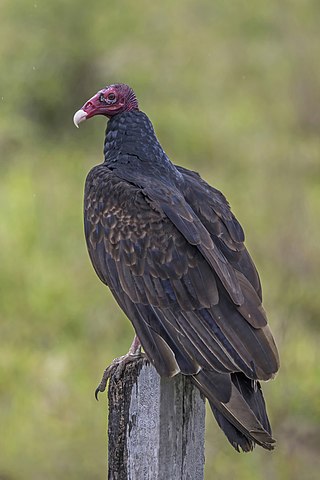
The turkey vulture is the most widespread of the New World vultures. One of three species in the genus Cathartes of the family Cathartidae, the turkey vulture ranges from southern Canada to the southernmost tip of South America. It inhabits a variety of open and semi-open areas, including subtropical forests, shrublands, pastures, and deserts.

The common starling, also known as the European starling in North America and simply as the starling in Great Britain and Ireland, is a medium-sized passerine bird in the starling family, Sturnidae. It is about 20 cm (8 in) long and has glossy black plumage with a metallic sheen, which is speckled with white at some times of year. The legs are pink and the bill is black in winter and yellow in summer; young birds have browner plumage than the adults. It is a noisy bird, especially in communal roosts and other gregarious situations, with an unmusical but varied song. Its gift for mimicry has been noted in literature including the Mabinogion and the works of Pliny the Elder and William Shakespeare.

The Pacific golden plover is a migratory shorebird that breeds during summer in Alaska and Siberia. During nonbreeding season, this medium-sized plover migrates widely across the Pacific.

The Andean condor is a South American New World vulture and is the only member of the genus Vultur. It is found in the Andes mountains and adjacent Pacific coasts of western South America. With a maximum wingspan of 3.3 m and weight of 15 kg (33 lb), the Andean condor is one of the largest flying birds in the world, and is generally considered to be the largest bird of prey in the world.

Bird ringing (UK) or bird banding (US) is the attachment of a small, individually numbered metal or plastic tag to the leg or wing of a wild bird to enable individual identification. This helps in keeping track of the movements of the bird and its life history. It is common to take measurements and examine conditions of feather molt, subcutaneous fat, age indications and sex during capture for ringing. The subsequent recapture or recovery of the bird can provide information on migration, longevity, mortality, population, territoriality, feeding behavior, and other aspects that are studied by ornithologists. Other methods of marking birds may also be used to allow for field based identification that does not require capture.
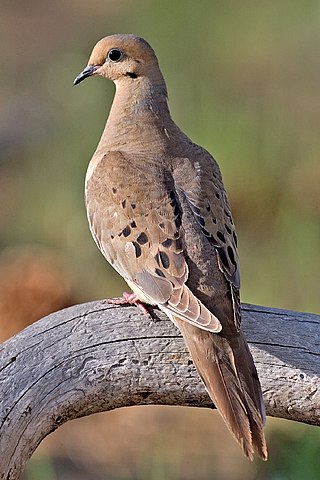
The mourning dove is a member of the dove family, Columbidae. The bird is also known as the American mourning dove, the rain dove, the chueybird, colloquially as the turtle dove, and it was once known as the Carolina pigeon and Carolina turtledove. It is one of the most abundant and widespread North American birds and a popular gamebird, with more than 20 million birds shot annually in the U.S., both for sport and meat. Its ability to sustain its population under such pressure is due to its prolific breeding; in warm areas, one pair may raise up to six broods of two young each in a single year. The wings make an unusual whistling sound upon take-off and landing, a form of sonation. The bird is a strong flier, capable of speeds up to 88 km/h (55 mph).
In biology, nidifugous organisms are those that leave the nest shortly after hatching or birth. The term is derived from Latin nidus for "nest" and fugere, meaning "to flee". The terminology is most often used to describe birds and was introduced by Lorenz Oken in 1816. The chicks of birds in many families, such as the waterfowl, waders, and gamebirds, are usually nidifugous.

Birds of Fire is the second studio album by jazz fusion band the Mahavishnu Orchestra. It was released in 1973 by Columbia Records and is the last studio album released by the original line-up before it dissolved.
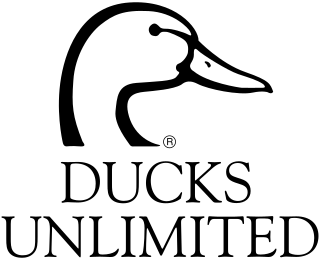
Ducks Unlimited (DU) is an American 501(c)(3) nonprofit organization dedicated to the conservation of wetlands and associated upland habitats for waterfowl, other wildlife, and people. It has had a membership of around 700,000 since January 2013.

"Surfin' Bird" is a song performed by American surf rock band the Trashmen, containing the repetitive lyric "the bird is the word". It has been covered many times. It is a combination of two R&B hits by the Rivingtons: "Papa-Oom-Mow-Mow" and "The Bird's the Word".
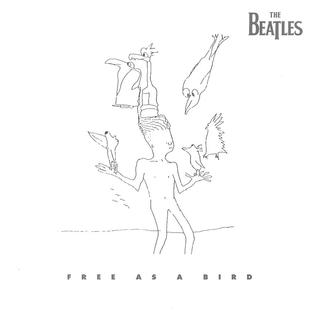
"Free as a Bird" is a single released in December 1995 by English rock band the Beatles. The song was originally written and recorded in 1977 as a home demo by John Lennon. In 1995, 25 years after their break-up and 15 years after Lennon's murder, his then surviving bandmates Paul McCartney, George Harrison and Ringo Starr released a studio version incorporating the demo.

Mrs. Hume's pheasant, also known as Hume's pheasant or the bar-tailed pheasant, is a large, up to 90 cm (35 in) long, forest pheasant with a greyish brown head, bare red facial skin, chestnut brown plumage, yellowish bill, brownish orange iris, white wingbars and metallic blue neck feathers. The male has a long greyish white, barred black and brown tail. The female is a chestnut brown bird with whitish throat, buff color belly and white-tipped tail.
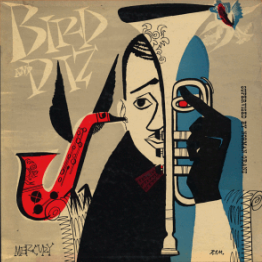
Bird and Diz is a studio album by jazz saxophonist Charlie Parker and trumpeter Dizzy Gillespie. It was recorded primarily on June 6, 1950, in New York City. Two tracks featured on the original pressing, "Passport" and "Visa", were recorded by Parker, without Gillespie and with different personnel than the other tracks, in March and May 1949. The album was originally issued in 1952 in 10" format as a collection of 78 rpm singles on the Verve subsidiary label Clef Records.

Cucamonga is a compilation album consisting of songs recorded with the involvement of Frank Zappa and Paul Buff at Pal Recording Studio in 1963-1964. In 2004, Rhino Records re-released the album with extra tracks and a new track order, after acquiring Del-Fi. The two songs performed by Paul Buff and the two songs performed by the Pauls have no Zappa involvement.

Pre-Bird is an album by jazz bassist and composer Charles Mingus consisting of music that was composed before Mingus first heard Charlie Parker, hence the title Pre-Bird. It was released on Mercury Records in September 1961.
xeno-canto is a citizen science project and repository in which volunteers record, upload and annotate recordings of bird calls and sounds of orthoptera and bats. Since it began in 2005, it has collected over 575,000 sound recordings from more than 10,000 species worldwide, and has become one of the biggest collections of bird sounds in the world. All the recordings are published under one of the Creative Commons licenses, including some with open licences. Each recording on the website is accompanied by a spectrogram and location data on a map displaying geographical variation.
Bird Islands Conservation Park is a 3.69-square-kilometre (1.42 sq mi) protected area in eastern Spencer Gulf, South Australia. It is located at Warburto Point on Yorke Peninsula, about 10 km (6.2 mi) south of the town of Wallaroo. In 1991, land additions were made to the park to include the intertidal zone of both islands. In 1999, a larger, mainland section was added to support mangroves, samphire and coastal fringe vegetation.
















